Review: 'The Worth of a Shell' and 'Clays Beneath the Skies', by M.C.A. Hogarth
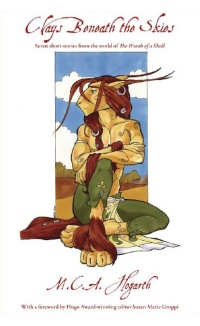
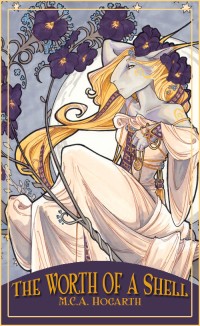 Maggie Hogarth’s Jokka s-f stories, featuring the tri-sexed scaly aliens of the planet Ke Bakil, made their debut in the short story “Money for Sorrow, Made Joy” in the Strange Horizons weekly online s-f magazine on November 26, 2001. Six further Jokka short stories followed to 2010; notably including “Unspeakable”, the third, also published on Strange Horizons on November 4, 2002.
Maggie Hogarth’s Jokka s-f stories, featuring the tri-sexed scaly aliens of the planet Ke Bakil, made their debut in the short story “Money for Sorrow, Made Joy” in the Strange Horizons weekly online s-f magazine on November 26, 2001. Six further Jokka short stories followed to 2010; notably including “Unspeakable”, the third, also published on Strange Horizons on November 4, 2002.
“Unspeakable” was a finalist for the 2003 Spectrum Award1 in the Short Fiction category, and was included in the Strange Horizons: Best of Year Two anthology. There have been more Jokka short stories since 2010.
Are the Jokka sufficiently Furry for Flayrah? Ever since Furry fandom voted overwhelmingly for Avatar over Fantastic Mr. Fox for Best Anthropomorphic Motion Picture in the 2009 Ursa Major Awards, it looks like anything alien is Furry enough. The Jokka have scales, manes, tails, moveable ears, and fangs; they drool venom; they lay eggs as well as having live births (their biology is VERY bizarre), and they look enough like bipedal horses that at least one reviewer has described them as “horse-like” despite their illustrations by Hogarth (and the author should know). Yes, that seems Furry enough.
“The Worth of a Shell”: North Charleston, SC, CreateSpace, October 2009, trade paperback $15.00 (394 [+ 1] pages, map), Kindle $3.99.
“Clays Beneath the Skies”: Tampa, FL, Stardancer Studios, June 2011, trade paperback $15.99 (xii + 183 [+ 1] pages), Kindle $3.99. Illustrated by the author. Foreword by Susan Marie Groppi.
The Worth of a Shell is the first Jokka novel. It opens:
When I was sent from House Mated for the second to last time in my life, it was to attend the Transactions Fair. I had not been tasked to find any specific addition for our Household, but the Fair transpired rarely and mingled entertainment with duty so pleasantly that I considered it more of a holiday. I hadn’t had a holiday in longer than I could remember . . . as the kaña-befidzu reminded me. (p. 3)
The novel is clearly for those who are already familiar with the earlier Jokka short stories. Fortunately, Hogarth collected them together two years later into Clays Beneath the Skies; cover-described as, “Seven short stories from the world of The Worth of a Shell”. Readers unfamiliar with the Jokka are advised to begin there.
Clays Beneath the Skies
The stories of Clays Beneath the Skies were written from 2001 to 2010 (the Chronology lists two more set earlier than The Worth of a Shell but not published until after Clays). They are arranged by internal chronological order, not the order in which they were published. This is fortunate, because they are exotic enough as it is. They are presented as if narrated by one Jokkad (Jokka singular) telling his/her/its story, assuming that his/her/its (for simplicity’s sake I will just use “his”) listeners will understand his cultural background. The seven stories cover generations, during which the Jokka evolve from migratory nomads to sophisticated town-dwellers, to a slow decline as Ke Bakil’s climate becomes increasingly arid and resources are used up.
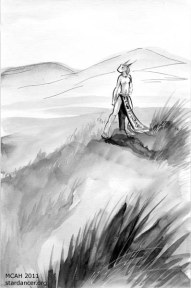 “Freedom, Spiced and Drunk” begins:
“Freedom, Spiced and Drunk” begins:
Before her mind died, my mother told me to speak all my memories into a conch shell before my clan gave me to a male. She showed me her own fragile talisman, let me rub my fingers along its slick white surface and smell its sea-salt fragrance. She said, be sure to examine it for holes other than its mouth, lest the words whispered into it leak away. If they do, the memories will be forever lost when pregnancy takes your mind. (p. 1)
The narrator is Kediil, born anadi, a female, but turned eperu, a neuter, with the first of the Jokkad’s two puberties, therefore retaining its intelligence; unlike the anadi who slowly become dumb animals after the physical trauma of pregnancy. The emodo, the physically strong but mentally fragile males, also risk losing their intelligence if they are subjected to excessive stresses such as extreme exhaustion or terror. The eperu, not subject to mind-loss, are the nomadic clans’ healers and teachers, their accumulated memory – the lore-knowers.
Learning of [healing] plants was not my only new duty. As the sturdiest of the three sexes, the eperu were called upon for many labors. One of these was the birth watch, for though our hands were not as clever as an emodo’s, we had the endurance to see an anadi through her pregnancy and to turn the baby if it had become twisted. (p. 7)
Kediil eventually learns one bit of medicinal lore that the eperu keep a close secret. There are plants that, if eaten by an anadi or emodo, will prevent mind-loss – at the cost of rendering them sterile. To keep the two breeder sexes from saving their intelligence but dooming their clans to die out from sterility, the eperu have withheld this knowledge from the fertile genders. How this knowledge affects Kediil makes the story.
“New Stories”, set a generation later, is narrated by Serel. There are new details about the Jokka:
Daridil was atypical for our kind: he’d remained male through both puberties, and it showed in the adult. Tall and limber, he had the emodo’s long fingers and flexible toes, perfect for complex and delicate work. His wedge-shaped head had a handsomely blunt end that complemented the triangular ears with their dark tufts. He was in some ways too perfect, for the family tended to overlook his mind while praising his body.
[ ... ]
We were not meant for heat, we Jokka. Too hot and our minds burn up and die, and the first to go are our breeders. (both p. 22)
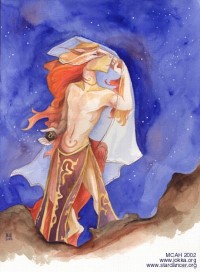 Because the exertion of constant travel is hard on the breeders, Serel has persuaded the clan to give up its nomadic wandering and settle in one place; but an unexpected heat wave threatens all of them. Kediil, now an elderly “madwoman” living alone in the hills, knows what to do, but only Serel will listen to her. (Yes, her.)
Because the exertion of constant travel is hard on the breeders, Serel has persuaded the clan to give up its nomadic wandering and settle in one place; but an unexpected heat wave threatens all of them. Kediil, now an elderly “madwoman” living alone in the hills, knows what to do, but only Serel will listen to her. (Yes, her.)
“A Trifold Spiral Knot” is set in and around Dardenil, the largest of the Jokka’s new mud-brick permanent towns. It is narrated alternately by the mystic Erdiil, who has been emodo, anadi, and eperu; and Mayiin, who has traveled for years to meet it. The Jokka begin developing a religion.
The four remaining stories (“Money for Sorrow, Made Joy”, “Unspeakable”, “His Neuter Face”, and “Fire in the Void”) relate the spread of towns, and the development of trade caravans to connect them; the evolution of urban life (notably the growth of clans into prestigious Houses) and the formalization of the religion; and the effect on all of them as the land of Ke Bakil dries up. Each story is told in the first person through a new narrator, and develops its background against a foreground interplay of the triple genders. A back-cover blurb quotes a reviewer as saying that the stories in Clays Beneath the Skies are “Strongly reminiscent of the work of Ursula LeGuin”, and they certainly do fall into that school of social s-f featuring non-traditional sexual themes. This collection includes a chronology and a glossary of Jokka vocabulary.
The Worth of a Shell
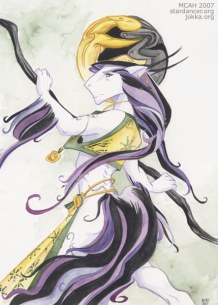 The Worth of a Shell, the Jokka novel, is chronologically the last of the stories (so far). The narrator is Thenet, the jarana of House Mated in the large town of Serean. A jarana is an anadi-guardian, an eperu so skilled that it is able to keep a House’s head anadi from losing her intelligence after giving birth. (Such anadi are the kaña-befidzu.) Thenet is tasked with caring for Kerdil, Mated’s kaña-befidzu – essentially the House’s prize female, valued as a breeder.
The Worth of a Shell, the Jokka novel, is chronologically the last of the stories (so far). The narrator is Thenet, the jarana of House Mated in the large town of Serean. A jarana is an anadi-guardian, an eperu so skilled that it is able to keep a House’s head anadi from losing her intelligence after giving birth. (Such anadi are the kaña-befidzu.) Thenet is tasked with caring for Kerdil, Mated’s kaña-befidzu – essentially the House’s prize female, valued as a breeder.
As the novel opens, Kerdil is expecting her second childbirth soon, which does not worry anyone; Thenet will ensure that Kerdil’s mind is not lost during childbirth, and Mated’s healer will ensure that the baby is born safely. Kerdil dismisses Thenet to enjoy Serean’s Transactions Fair; an enjoyable holiday before it must assist at the anadi’s childbirth. But Thenet returns from the Fair to find Kerdil in the throes of a premature birth, when the House healer is also absent. The child is stillborn despite Thanet’s efforts to save it, and the distraction destroys Kerdil’s intelligence as well. Thenet is blamed for both losses and exiled from House Mated – effectively sentenced to death, since as a castoff it is outlawed and cannot expect to be taken in by any other House in Serean.
Thenet is saved from being killed by Dlane, a beautiful anadi who has rejected the Jokka tradition of becoming a pampered breeder for some prestigious House at the risk of her intelligence. Dlane is escaping from Serean, and she drafts Thenet to help her survive in the dry wilderness outside the town. Thenet, who believes that it deserves its death as tradition demands in this case, is shocked by the female who does not want to become a mother:
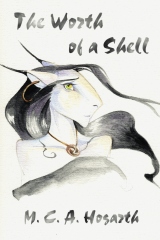
But bearing children is a duty we reward the anadi amply for. They are showered with jewels and scarves made by the emodo, zealously guarded and provided for by the eperu, allowed to live a life of leisure in rooms with pools of water to keep their skin smooth and cool and servants to offer them flavored waters and candied meats.
A life of pleasure and purpose.
A life that Dlane did not want. (p. 30)
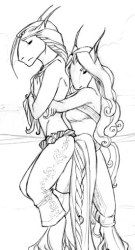 Thenet, who feels that it should be dead and is living on borrowed time, is content to let Dlane be their leader. Dlane, who does not really have a goal besides leaving Serean, decides to investigate the reality behind “what everybody knows” – the age-old legend of how the Jokka became sapient beings:
Thenet, who feels that it should be dead and is living on borrowed time, is content to let Dlane be their leader. Dlane, who does not really have a goal besides leaving Serean, decides to investigate the reality behind “what everybody knows” – the age-old legend of how the Jokka became sapient beings:
I drew abreast of her, touching her shoulder. She glanced at me then stepped back and let me lead. I turned us toward the trees. ‘Ke anadi, what do you hope to find at the Birthwell?’
Dlane trotted behind me. ‘Do you believe the stories are true?’
‘That the first Jokkad had the first thought there? That our race was born with that thought?’ I shrugged, a flip of my tangled black tail. ‘I have never had any reason not to believe it.’
Silence. Then: ‘I want to go there. I want to see the place where our ability to think, to rejoice and laugh and weep first came to us.’
‘Why?’ I asked again.
‘I have my reasons,’ she said, and I sensed I would have no more from her on this topic – not for now, at least. (pgs. 30-31)
Thenet and Dlane have many adventures together between pages 30 and 394, on their oft-interrupted journey to the far-distant, semi-legendary Birthwell. Their travels are complicated by the physical differences between the hardier eperu and the determined but delicate anadi. They encounter other beings of Ke Bakil’s fauna; the lithrekid, the ñedsu, the carrion-eating moths, the wingflutter. During their travels Thenet is at first the conservative, the upholder of orthodoxy, of the individual’s role in structured Jokka society; until it comes to understand Dlane’s fight for a Jokkad’s right to become a true individual, independent:
‘Noble female!’ she said, scoffing. ‘Respected female! I am neither! I am a person foremost, Thenet. Not a womb. I have dreams.’ (p. 46)
Thenet and Dlane are only two-thirds of the Jokka triad. As far as they are concerned, they need an emodo like, to use the very out-of-place modern American idiom, “a fish needs a bicycle.” But the novel does need an emodo to become complete. He is Roika, who wanders in and out of the story for his own purposes, but who turns out to be as unorthodox for an emodo as Thenet and Dlane are for an eperu and an anadi.
The Worth of a Shell is a long novel, blending the elements in the individual stories of Clays Beneath the Skies into a more complex whole. It is easy to see why, after completing this, Hogarth went back to write more tales of the Jokka’s past. Will there be any stories set after The Worth of a Shell to tell of the Jokka’s future?
Review copies were provided by the author.
? “The Gaylactic Spectrum Awards were created in 1998 by the Gaylactic Network to honor works in science fiction, fantasy and horror which include positive explorations of gay, lesbian, bisexual or transgendered characters, themes, or issues. In 2002, the Awards were handed over to a newly formed, independent organization - the Gaylactic Spectrum Awards Foundation.” (The Gaylactic Spectrum Awards website)
About the author
Fred Patten — read stories — contact (login required)a retired former librarian from North Hollywood, California, interested in general anthropomorphics
Comments
There are enough other Jokka shorts that I will probably do a second collection; but it's worth noting that "Stone Moon, Silk Scarves" is the last story in the chronology. It is a partial sequel to Shell and is available as an e-novella on Smashwords (https://www.smashwords.com/books/view/60846) and Amazon (http://www.amazon.com/Stone-Moon-Silk-Scarves-ebook/dp/B0051VG0OS/). :)
Post new comment